Top 7 Yoga Poses for Youthfulness
In the present world, Yoga is an integral part of the lives of human beings. An excellent practice of maintaining physical and mental vitality into old age through the development of flexibility, strength, and clarity of mind. It aids in the proper flow of energy for reducing stress and maintaining well-being. We present the top 7 yoga poses for youthfulness or anti-ageing where one feels re-energized, improves posture, and maintains a vibrant and youthful spirit with regular practices.
Top 7 Yoga Poses for Youthfulness or Anti Ageing
A. Ustrasana (Camel Pose)
Ustrasana, or Camel Pose, is a deep backbend yoga pose. In this pose, a yoga practitioner kneels and curves the back, reaching hands toward the heels. It’s among the 26 asanas in the Bikram Yoga series.
Steps
- Kneel on the mat with your feet flat on the floor, toes pointed backward.
- Hips aligned with knees and the spine softly arched.
- Keep the chest open, head up, and elbows back.
- Slowly place your hands on your heels (or lower back for beginners).
- Look up with a slight backward tilt.
- Keep your neck soft and hold for 10-20 seconds while breathing hard.
- Release by lifting your chest upwards and with the support of your hands, rise to an upright position slowly.
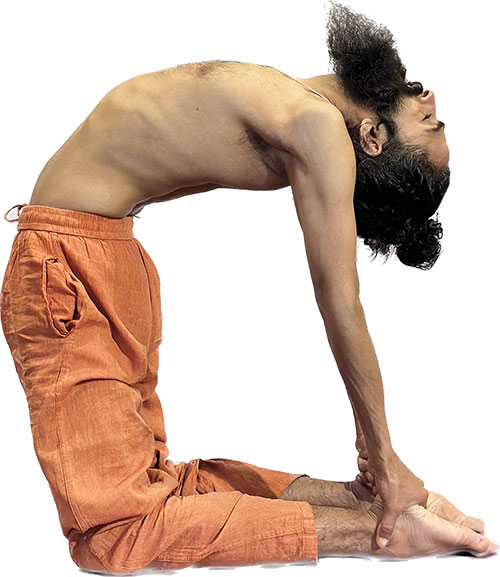
Ustrasana Benefits
- This backbend pose opens up the chest and gives a good stretch to the entire front of the body, which enhances circulation and stretches the stiffness out, promoting a youthful, energetic posture.
- Ustrasana supports detoxification and helps in maintaining weight by improving the metabolic rate.
- It expands the chest and increases lung capacity thus stimulating the health chakra.
- The forward stretch of the body opens up the abdominals, hip flexors, and quadriceps.
- It cures flabby shoulders and correct postures in case of regular practice.
- The organs in the digestive system are stretched which is very helpful for metabolism and digestion.
- It minimizes back problems and makes the spine flexible.
Ustrasana Side Effects
- Improper practice results in injury to the lower back or neck.
- Therefore, this yoga posture is better avoided if one has certain back and neck problems for some time.

B. Tadasana (Mountain Pose)
Tadasana or mountain pose is a basic standing posture that stands straight, with the feet together, and legs straight. The body aligns with hands alongside the body, a wide chest, arched shoulders, and the crown of the head upwards.
Steps
- Stand on a mat with a straight-legged posture, the feet together, heels slightly apart, and wide-set toes.
- Draw your weight evenly into the body and slowly lift your kneecaps.
- Open your chest wide, straighten your spine, and keep your shoulders aligned over your hips.
- Stretch your hands straight up with palms facing forward.
- Tilt the crown of the head upwards without tilting the chin upwards but keeping it parallel to the ground.
- Remain in a steady pose for 15-30 seconds, breathing slowly.
- Bring your hands down and back into a normal standing position.
Tadasana Benefits
- This asana supports a straight posture by giving strength to the core and spine and reduces the ageing signs due to better body mechanics.
- The leg and foot muscles strengthen thereby contributing to better balance and coordination.
- Proper body alignment improves blood circulation and respiration.
- It calms the mind and improves concentration promoting mental focus.
- It increases body awareness and balance and helps efficient movement ultimately promoting weight management.
Tadasana Side Effects
- The improper alignment of hips, feet, or shoulders can cause strain in the lower back or knees.
- Avoid knee locking for those people having knee problems.
C. Chakrasana (Wheel Pose)
Chakrasana, or Wheel Pose is a backbend asana in an advanced form where practitioners lift their body into a full curve. The other name for this asana is Urdhva Dhanurasana.
Steps
- Lie flat on the mat and bend your knees and feet.
- Keep hip-width apart and place your hand and fingers directed toward your shoulders with your elbows bent.
- Lift your hips upward facing with hands and feet pressing into the mat.
- Straighten the arms, and lift the back in an arch.
- Continue pressing the feet and hands down while lifting the chest and head.
- Push back, keeping your aim to get a deep backbend.
- Keep your legs and arms straight with an open chest.
- Keep on inhaling and exhaling throughout while holding for 15-30 seconds.
- Slowly bend the elbows and knees, gently lay your back on the mat, and rest to release.
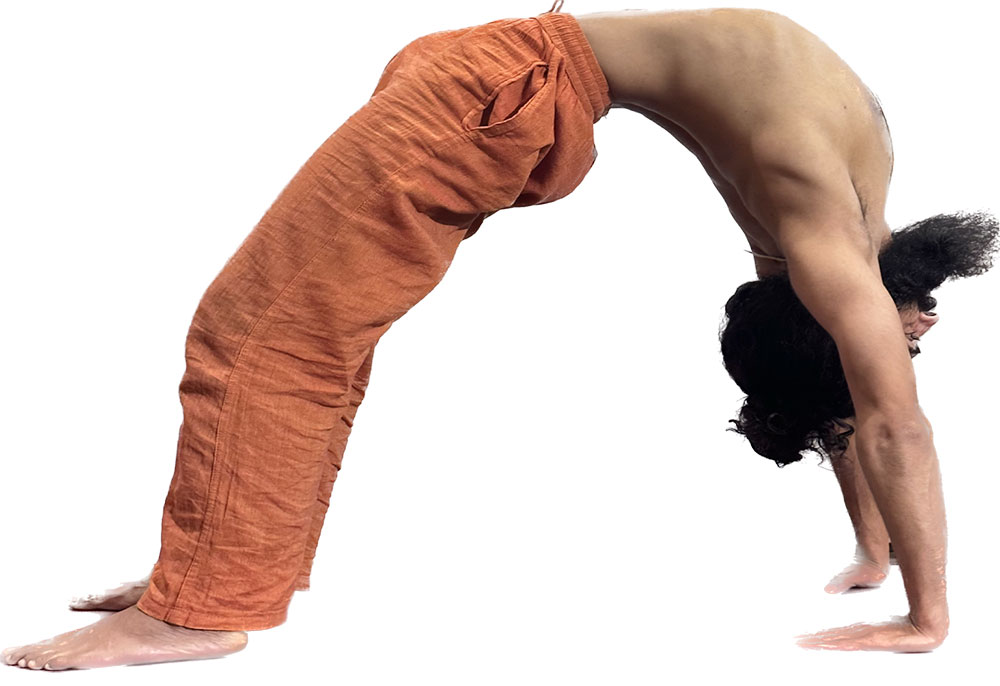
Chakrasana Benefits
- It makes the spine, chest, and shoulders more flexible, hence rejuvenating the nervous system and contributing to a feeling of vitality and youthfulness.
- The core, arms, and legs strengthen and stabilize.
- The breathing progresses with an improvement in chest and lung capacity.
- It activates the nervous system and promotes vitality.
- Regular practice of this pose gives back pain relief.
- Proper blood circulation and muscle strengthening help to burn body fat resulting in weight loss.
Chakrasana Side Effects
- The incorrect practice may cause strain on the lower back or neck.
- Avoid this pose if suffering from spinal problems or any neck problems.
D. Vajrasana (Thunderbolt Pose)
Vajrasana, or Thunderbolt pose, is the only yoga posture that can be done on a full stomach. This posture involves sitting on the knees with the calves underneath the thighs.
Steps
- Kneel on the mat, and put your toes together and heels apart.
- Rest on the bottoms and place the gap in between your heels.
- Set your hands in Jnana or Chin Mudra, and place them on the knees.
- Keep your back straight and close your eyes.
- Hold for 30 seconds to a few minutes, focusing on deep and sound breathing.
- Slowly come out of this pose by sitting back and lengthening your legs straight out in front of you to release.
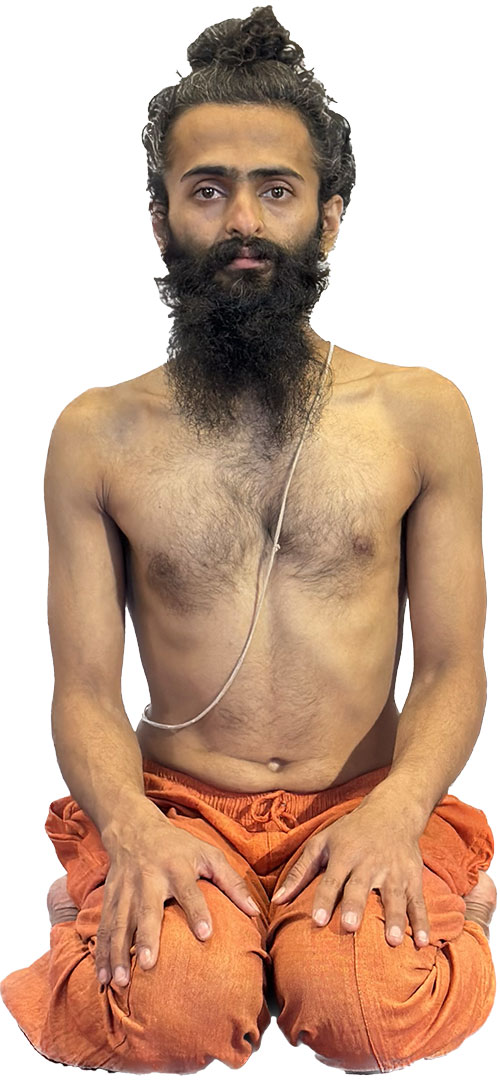
Vajrasana Benefits
- This asana calms the mind reducing stress and stimulating peace and clarity. It further promotes staying healthy and youthful.
- Performing Vajrasana after meals decreases bloating allowing proper digestion and regulating metabolism. It indirectly supports weight loss.
- The overall lower body postures strengthen, align, and improve while sitting in this pose regularly.
Vajrasana Side Effects
- Avoid this pose if one has injuries to the ligaments either at the knees or ankles.
- Those with severe pains of arthritis, intestinal ulcers, and hernia patients should not attempt this pose.
E. Marjari-Bitilasana (Cat-Cow Pose)
Marjari-Bitilasana, or Cat-Cow pose, is an active movement of the spine that flows between two postures. During the marjari pose, the practitioner rounds the back and tucks the chin toward the chest. During the bitilasana pose, the back is arched, and the chest is raised.
Steps for Marjari-Bitilasana
- Set yourself in Bharmanasana (tabletop position), keep the hips directly above the knees and the hands shoulder-width apart.
For Bitilasana (Cow Pose)
- Inhale as you allow the tummy to drop toward the mat, lifting your chest and tailbone.
- Open your chest and bend your back, looking slightly upward.
For Marjari (Cat Pose)
- Exhale as you round your back toward the ceiling.
- Tuck your chin in toward your chest and draw your navel toward your spine.
- Extend the stretch by pressing the mat with your hands and knees.
- Continue with these two postures, consecutively, in sync with your breath.
- Practice 5-10 rounds of the Marjari-Bitilasana pose effortlessly with every inhale and exhale.

Marjari-Bitilasana Benefits
- Marjari-Bitilasana (Cat-Cow Pose) stimulates internal organs for a youthful and energetic body.
- It improves spinal flexibility activating body mobility and strengthening abdominal muscles.
- The back, neck, and shoulder stiffness gets relieved.
- The improvement in digestion increases metabolism helping in weight loss.
- It promotes better breathing sequences.
Marjari-Bitilasana Side Effects
- People may experience lower back or spine irritation if the movements are not done properly.
- The stiffness in the neck or back due to overstretching.
F. Pawanmuktasana (Wind-Relieving Pose)
Pawanmuktasana or Wind Release Pose is a body in a supine position where you bring your knees towards the chest and interlocking hands.
Steps
- Lie down on your back on the mat.
- Lengthen your neck, and shoulders down.
- Gently bend both knees, take toward the chest, and interlock both your hands.
- Interlock both hands on knees, squeeze up the abdomen, and hold both sides of an elbow (if you prefer it).
- Pull the navel inside as you exhale.
- Hold your back up and try taking your chin towards the knee.
- Keep holding for 15-30 seconds with deep breaths.
- Drop your navel down and keep your lower back down.
- Exhale and keep down your upper back.
- Stay as it is for a few breaths.
- Stretch your legs down and relax.
Pawanmuktasana Benefits
- Pawanmuktasana or Wind-Relieving Pose aids digestion promoting deep relaxation and developing a youthful feeling.
- Regular practice stimulates bowel movement, improves digestion, and helps in reducing body weight.
- It stimulates the digestion organs, improves metabolic functions, and strengthens the abdomen.
- The asana eases lower back discomfort and relieves stress.
Pawanmuktasana Side Effects
- Inappropriate posture and alignment strains the back or hips.
- People suffering from knees or back should carefully attempt this pose.
G. Paschimottanasana (Seated Forward Bend)
Paschimottanasana or Seated Forward Bend pose, where practitioners stretch out their legs in a straight position, lengthen the spine, and expand the chest. Then, bend forward to reach feet, ankles, or toes as their flexibility and rise raising hands slowly. The other name for this asana is Intense Dorsal Stretch.
Steps
- Sit on the mat and bring both legs in front of you with pointed toes inward.
- Keep your back straight, lengthen the spine, and expand the chest.
- Inhale and raise both hands, extending the spine further.
- Bring the hands in alignment with the ears.
- Exhale, bring the chin out, and bend down as you can.
- Reach for your feet, ankles, or toes as your flexibility.
- Bring your elbows down on either side of the feet.
- Bring your forehead to rest on your legs.
- Raise your hands slowly in line with your ears.
- Inhale, extend the spine upward.
- Exhale, bring both hands down, and release.
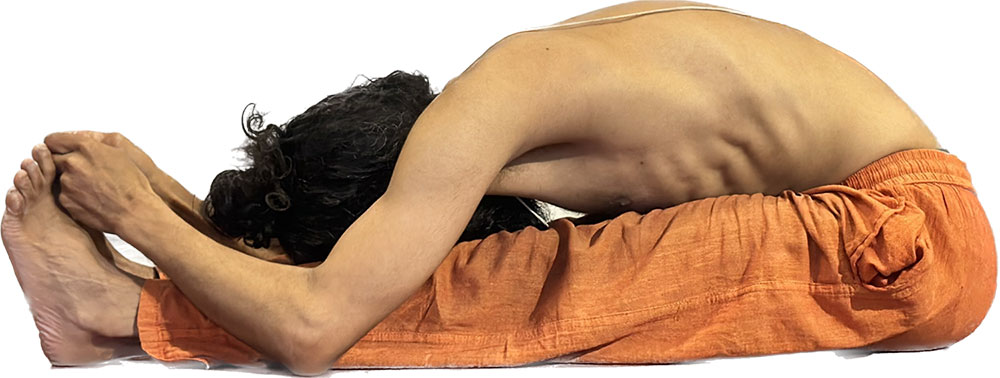
Paschimottanasana Benefits
- Paschimotanasana or Seated Forward Bend pose promotes youthfulness by giving clarity and flexibility to the mind.
- The liver and spleen function properly and strengthen the lumbar and sacral regions.
- One of the ideal poses for people with diabetes.
- It balances metabolism, builds up appetite, and improves digestion for weight loss.
- The flexibility in the body improves due to stretching.
- People get relief from hamstring, calves, neck, and lower back muscle pain as it eases the nervous system.
Paschimottanasana Side Effects
- The inappropriate practice of this pose causes strain on the lower back, shoulders, neck, or hamstrings.
- Be careful while stretching if the practitioner suffers from lower back pain.
Conclusion
The regular and proper practice of these yoga poses enhances flexibility in the body and keeps both mind and body youthful. Improvements in digestion, comfort in the nervous system, and emotional balance bring a positive approach to life, ultimately slowing the ageing process.
Written By: Anjali B
Magical Benefits of Maha Mrityunjaya Mantra
The Maha Mrityunjaya Mantra is a powerful sacred mantra associated with longevity, protection, healing, and sound health. Lord Shiva’s mantra is mentioned in Hindu Vedas such as Rig Veda (7.59.12), Yajur Veda (3.60), and Atharva Veda (15.1.17) affirming its significance. People believe regular chanting of this mantra calms the soul and removes fear. This mantra is so powerful that people think it protects from misfortunes and prevents premature death. There are several magical benefits of Maha Mrityunjaya Mantra in an individual’s life as this mantra is also known as the ‘Death Conquering Mantra’.
The Maha Mrityunjaya Mantra in Sanskrit
ॐ त्र्यम्बकं यजामहे सुगन्धिं पुष्टिवर्धनम्।
उर्वारुकमिव बन्धनान्मृत्योर्मुक्षीय मामृतात्॥
English Transliteration
Aum Tryambakam Yajamahe Sugandhim Pushtivardhanam,
Urvarukamiva Bandhanan Mrityor Mukshiya Mamritat.
Meaning
Aum, we bow to the three-eyed Lord Shiva,
We seek to enhance the vitality and fragrance in us,
May, he releases us from the bondage of death effortlessly,
And may, He bless us with immortality.
Word-for-word Explanation
Aum (Sacred Sound)
The magical sound Aum, the primordial sound is the fountainhead of all Vedic Chanting. Mundaka Upanishad says: “Aum is the bow, the individual self is the arrow, and the spirit is the target. One should then become one with it like the arrow that has penetrated the target.”
Trayambakam (Shiva-the third-eyed one)
The third eye represents Wisdom, knowledge, and destruction that symbolize divine perception. It is used to appeal to Lord Shiva’s blessings for protection and liberation.
Yajamahe (We Worship, We Surrender)
The act of communicating with the divine to attain the divine’s blessings and protection by dedicating oneself through the method of worship and surrendering.
Sugandhim (Fragrance)
The whole universe has a presence of Divine’s Fragrance that purifies and brings harmony.
Pushtivardhanam (Nourishment and Strength)
One who nourished the infinite life, sustaining the energy of the universe. The self-existing principle of life. The power behind all that is.
Urvarukamiz Bandhanaa (A cucumber freed from its vine)
The soul ripened by his grace freed from all the enmeshments of life releases itself from the creeper of life.
MrityorMukshiya (Liberate me from Death)
A prayer summoning divine grace to liberate from the cycle of birth and death.
Mamritat (Grant me immortality)
An appeal for divine blessings to transcend mortality and attain spiritual liberation.
Various Names for Maha Mrityunjaya Mantra
There are various names for Maha Mrityunjaya Mantra which ultimately connects with the divine for protection, healing, resilience, and liberation from death. Some of the names are:
Rudra Mantra: It associates itself with Lord Shiva’s fierce form, Rudra.
Tryambakam Mantra: It names itself after the three-eyed form of Lord Shiva, symbolizing the past, present, and future, along with the ability to perceive beyond the ordinary.
Immortality Mantra: Highlights its ability to bestow health, longevity, and protection.
Death Conquering Mantra: The mantra provides healing by overcoming death and granting longevity.
History of Maha Mritujanya Mantra
The Maha Mrityunjaya Mantra is a composite hymn attributed to Vasiṣṭha Maitrāvaruṇi that first appeared in Rig Veda (7.59.12). It is associated with the legend of Markandeya. The parents, Rishi Mrikandu and his wife Marudmati prayed for a child to Lord Shiva. They were granted a child but were destined to die young. Markandeya was a brilliant child and very much devoted to Lord Shiva. Yama, the god of death came to take his life on his 12th birthday. Markandeya also came to know all about his birth’s reality and he immediately surrendered himself to Lord Shiva. His devotion impressed Lord Shiva and he granted him the boon of immortality. Lord Shiva blessed him with a death-defying powerful mantra, the Maha Mrityunjaya Mantra. Ultimately, this mantra saved him and became the divine’s blessing as a source of eternal protection.
Importance of Maha Mrityunjaya Mantra
The Maha Mrityunjaya Mantra is associated with Faith Healing and Prayer Healing as it is specially meant to ward off calamities, accidents, adversities, illness, etc. Does this mantra work? Well, faith is the only answer. If you chant this mantra with faith and full devotion, the pranic flows start within the body. The various mental wave patterns build up enhancing physical well-being, long life, and warding off misfortunes. In a healthy body state, feel positive energy, inspiration, and strength. This is a Vedic mantra with healing powers. So, surrender yourself to the divine and chant this mantra and by the grace of the divine, it can work wonders.
Magical Benefits of Maha Mrityunjaya Mantra
1. Longevity and Protection
There is a strong belief that chanting this mantra protects from untimely demise and misfortunes increasing the longevity of the person.
2. Healing Power
The mantra attains abundant healing power properties which are beneficial for the physical health of the person. Daily reciting the mantra provides relief from illness and minimizes the negative effects of chronic diseases.
3. Spiritual Awakening
Reciting the mantra with full devotion and passion creates a positive effect on the mind, body, and soul of the person. Further, it aids them in awakening spiritual consciousness.
4. Protection from Negative Energies
The powerful mantra channels all positive energies. Thus, chanting this mantra regularly protects from negative energies as it acts as a safety net against all harmful influences.
5. Spiritual Liberation
The mantra is also fondly called the ‘Mantra of Liberation’. People believe it guides the soul toward immortality and eternal peace, transcending the cycle of birth and death.
6. Peace and Calmness
Reciting this mantra daily proves to bring inner peace and calmness reducing anxiety and stress. It further helps to lead a balanced life.
7. Deep State of Meditation
People can include this powerful mantra in their meditation sessions to attain a deep sense of meditation and connect with the high power.
8. Overcoming Obstacles
Reciting this mantra proves to overcome obstacles in the life of an individual on both material and spiritual levels. The positive energy attained from chanting this mantra guides the person to deal with the obstacles wisely.
9. Purification of the Mind, Body, and Soul
The regular chanting of the mantra takes out impurities and negative thoughts from the individual. It purifies the mind, body, and soul guiding them to spiritual clarity and self-realization.
How to Practice the Mahamrityunjaya Mantra
Time: Choose the early morning, the Brahma Muhurta to chant the mantra.
Rituals: Bath daily and wear clean clothes.
Place: Choose a quiet place and sit on a mat in a comfortable meditation pose.
Prepare Yourself: Keep your mind, body, and soul calm, focus, and close your eyes.
Recitation: Use a japa mala (108 rosary beads) and chant the mantra slowly with proper intonation. Follow the vibration and feel the resonance effect throughout the body. Focus on the meaning of the mantra while chanting.
Mantra Frequency: It is best to chant 11, 21, or 108 times daily. However, chant the mantra as your preference.
Closing: Complete the chant with your chosen frequency (11, 21, or 108) times. Pay gratitude to Lord Shiva, and seek his blessings for positive energies and longevity.
Conclusion
The Maha Mrityunjaya is a powerful mantra for longevity, sound health, healing, protection, and spiritual growth. Surrender to the divine while chanting the mantra with full devotion and passion. Achieve spiritual clarity through the purification of the mind, body, and soul and get blessed with positive energies, and power to overcome obstacles.
Written By: Anjali B
Agni Mudra and its Benefits
Himalayan Yoga Nepal is delighted to present an article on ‘Agni Mudra and its Benefits‘ to provide simple yet insightful facts to readers. Mudras have been a crucial part of yoga and meditation practices for thousands of years in ancient Hinduism and Buddhism traditions in Nepal and India. Mudras can be found in various forms. In a simple word, Mudra is a symbolic representation of hand or body gestures that channel the life force’s (prana) flow to balance the body’s energy. Among numerous Mudras, Agni Mudra is one of the most beneficial hasta mudras to stimulate and maintain the fire element within to improve digestion and balance the body and mind. Agni Mudra is popularly called Surya Mudra as it activates the Manipura Chakra or the sunlight-based plexus. Agni Mudra can be practiced by everyone irrespective of age or fitness level by consulting with an expert Yoga instructor.
How to Practice Agni Mudra
- Select a comfortable sitting position such as Sukhasana (Easy Pose), Padmasana (Lotus Pose), or Vajrasana (Thunderbolt Pose).
- Sit comfortably on a mat with a straight spine and relaxed neck.
- Rest your palms facing upwards on the thighs.
- Fold the tip of the ring finger against the base of the thumb.
- Held remaining fingers straight.
- Form the same Agni mudra with both hands.
- Maintain this position and gently close your eyes.
- Pay attention to your intention and breath.
- Take slow deep breaths.
- Relax and inhale positive energy and warmth.
- Exhale and release any tension or negativity.
- Continue this process for 10-15 minutes holding the Agni Mudra.
- Release the mudra, straighten your fingers, and relax your hands and body posture.
Benefits of Agni Mudra
Accelerates Digestion
The mudra stimulates the digestive fire which accelerates digestion. It clears toxins, improves metabolism, and reduces indigestion and constipation signs.
Reduces Stress and Tension
The mudra reduces stress and tension as it balances the fire element in the body and calms the nervous system. It further aids in maintaining the body temperature.
Controls High Cholesterol
It regulates the body’s metabolic processes which helps to lower cholesterol levels and controls high cholesterol.
Improves Vision
This mudra benefits eye health by improving vision as the fire element is associated with the eyes.
Balance Thyroid Hormones
This mudra prevents thyroid-related disorders as it helps to balance the thyroid-gland hormones by regulating the body’s metabolism.
Relieves Cold and Cough
The fire element produced through this mudra helps to warm the body by balancing the fire element relieving cold and cough.
Boost Self-Confidence and Willpower
It helps to boost self-confidence and willpower as this mudra balances the fire element within the body.
Relieves respiratory issues
The heat generated in the body helps in eliminating congestion and secretions from the lungs and sinuses. As a result, it relieves respiratory issues like asthma, bronchitis, etc.
Improves Blood Circulation
This mudra improves blood circulation which further impacts getting joint pain relief, and reduces inflammation.
Overcomes Obesity
Practicing Agni mudra daily helps to increase the metabolic rate and balances digestion which can result in overcoming obesity.
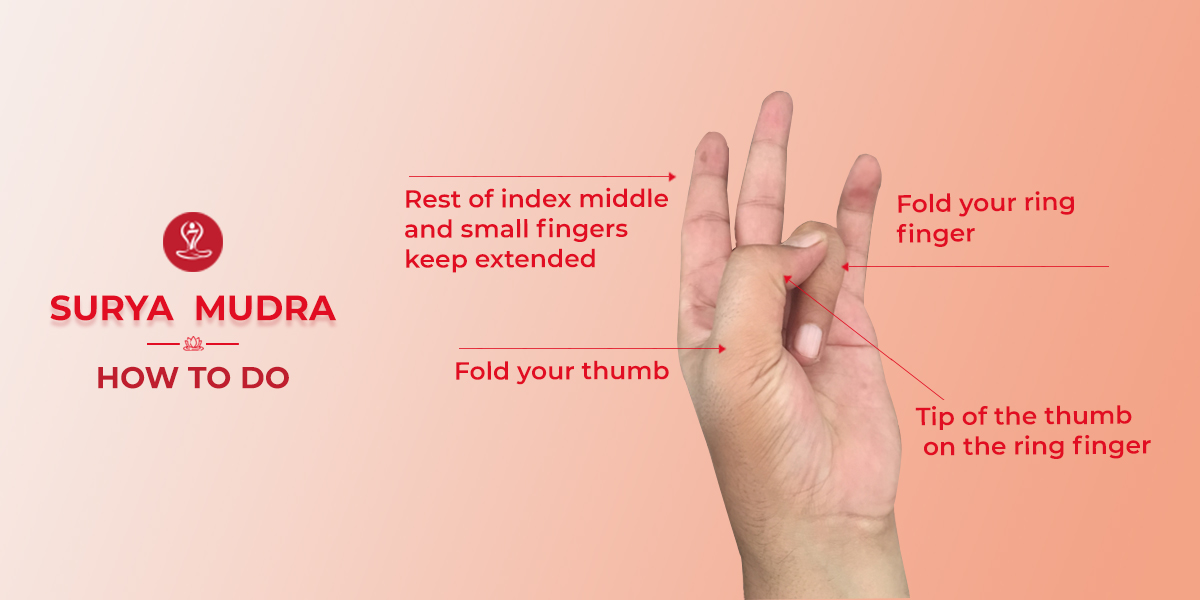
Agni Mudra Side Effects
Headaches or Dizziness
The improper practice of Agni Mudra can cause headaches or dizziness. So, consult or practice under the guidance of a qualified yoga instructor.
Excessive heat generation
Practicing Agni mudra for long hours can arouse digestive fire causing excessive heat generation in the body. As a result, observe an effect on the functioning of abdominal organs such as bloating, indigestion, or discomfort.
Uneasiness or pain
Practicing this mudra for long hours or in an improper way can cause uneasiness or pain in body postures and fingers.
Injuries or rashes
If not practiced correctly, one can experience injuries or skin rashes due to excessive sweating.
Imbalance and health issues
The imbalance of the five elements in the body can be seen while not correctly practicing Agni Mudra which leads to various health issues.
Things to Consider for Practicing Agni Mudra
- Consult or practice under the guidance of a certified yoga instructor if practicing Agni Mudra for the first time or have any queries related to it.
- This Agni Mudra is best when practiced by combining other Yoga asanas, with deep breathing and meditation.
- Start slowly on your pace and increase the duration and intensity gradually.
- Don’t practice Agni Mudra if you are having hormonal imbalances, during periods, weak health conditions, and high fire elements inside the body.
- Make sure to use proper breathing and relaxation techniques to get maximum benefit and comfort.
- Stop practicing if you experience any uneasiness or pain.
- Listen to your body and don’t force yourself.
Written By: Anjali B
